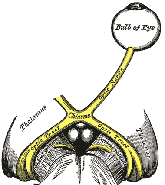
Home

Lab Tour

Lab Syllabus

Papers

Symposium
 Resources Resources
-
-
|
-

Lab 7: The Frog Heart
[Reading] [Overview] [Useful Links] [Lab Report] [Further Study]
Pre-lab reading
- Lab manual - pages 67-74
- Vander, Sherman, and Luciano - Chapter 14, especially section C: the heart.
Overview
Your heart outperforms any artificial mechanical device. It pumps blood through 60,000 miles of internal plumbing to allow exchange of materials across two acres of capillary surface at a cost of 16% of your energy consumption at rest, yet constitutes only 0.5% of body weight. Its output can be adjusted over a six-fold range between rest and strenuous exercise. With luck, you can expect your heart to beat 3 billion times without a hitch over your lifetime. The measurement of cardiovascular parameters, including heart rate, blood pressure, and the electrocardiogram, provides some of the most useful and widely used indicators of human health and activity. Over the next three labs you will learn to use these parameters to investigate how the circulatory system works, and, more generally, how the body responds to a variety of stresses and activities.
One way to study the function of an organ is to perturb it and monitor its response. In this lab you will observe a live beating heart and then subject it to a variety of chemical, physical, and electrical perturbations to understand how heart rate is regulated. Because of the invasive nature of this study, we will give our usual experimental subjects (ourselves) a break and employ frogs, which have been double-pithed to eliminate pain and consciousness. To measure the rate and strength of heart contraction, you will attach the exposed frog heart to a force transducer and record the force exerted by the contraction of the atria and ventricle. With this preparation, you can manipulate temperature, apply neurotransmitters, apply electrical stimuli directly to the heart, and create partial or complete atrioventricular (A-V) blocks. The questions you can investigate include:
- What is the sequence of contractions in the cardiac cycle and how does it correlate with the recorded force?
- How does the temperature of the heart affect its rate?
- How do the neurotransmitters responsible for regulation of heart rate in mammals affect heart rate in the frog?
- What effect does an artificial pacemaker have on the heartbeat?
- What effect does an A-V block have on the heart rhythm?

Useful Links
Lab Report
Introduction: Briefly state the purpose of your observations (section IV) and the two experiments you performed in section V. State your hypotheses for the two experiments.
Material and methods: Describe your two experiments, including details of temperatures, drug concentrations, voltages applied, etc. You do not need to give a complete list of materials or details about equipment and techniques that are already described in the lab manual.
Results: Some of the observations you will make in your experiments will be qualitative rather than quantitative, so may not lend themselves to statistical analysis. When that is the case, you may include short exerpts from the chart to document your observations. When possible, make replicated quantitative measurements (heart rate, force of beat) and present graphs and statistical analyses of the data. Include the relevant StatView tables for all analyses you performed.
Discussion: Interpret your results in light of your hypotheses. Describe the physiological mechanisms that might account for your findings. Your discussion should be guided by the questions in the manual.
Animation of frog internal anatomy from Lawrence Berkeley Lab
Further Study at Berkeley
Courses related to this lab topic
IB130/130L. Evolutionary and Functional Vertebrate Morphology. The structure and function of vertebrates; analysis of patterns of evolution of vertebrates using morphological data and the comparative method. (M. H. Wake)
IB150. Physiological Ecology of Animals. Comparative animal physiology with emphasis on adaptation to the various aspects of the physical environment, such as gases, temperature, water and ions.
IB158. Biology and Geomorphology of Tropical Islands. Natural history and evolutionary biology of island terrestrial and freshwater organisms, and of marine organisms in the coral reef and lagoon systems will be studied, and the geomorphology of volcanic islands, coral reefs, and reef islands will be discussed. Features of island biogeography will be illustrated with topics linked to subsequent field studies on the island of Moorea (French Polynesia). OK, so it's totally irrelevant to this lab, but you get to spend 9 weeks on Moorea and there must be frogs, right?
Faculty doing research related to this lab:
- Marvalee H. Wake. (IB) Vertebrate evolutionary morphology and reproductive biology.
- David B. Wake. (IB) Herpetology and evolutionary biology.
-
Links on these pages to commercial sites do not represent endorsement by the University of California or its affiliates.
IB 132 Lecture Website
Department of Integrative Biology
U. C. Berkeley
-
-
-
Last updated 1/13/06
- Copyright © Department of Integrative Biology. All rights reserved 2006
-
-
-
|
|